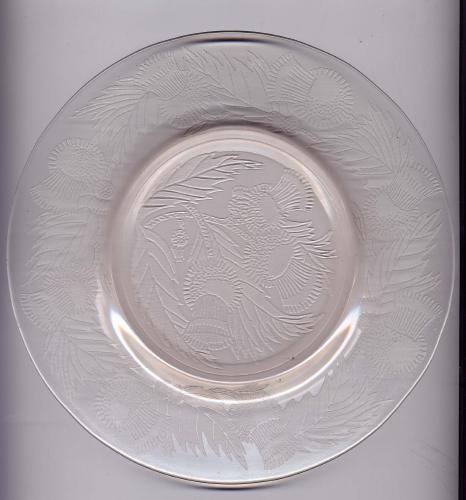
Collecting Thistle
Written by Rosemary Trietsch
I’ve been saying for a while that if I were to collect a pink pattern, it would be Dogwood. Yesterday, I think I changed my mind. In with a bunch of other glass, I found a pink Thistle luncheon plate. Every collector knows the feeling of excitement that comes when you’re digging in a box of trash and suddenly a treasure shows itself: the lid for your cookie jar or the salt shaker to go with your pepper. But I’m in trouble. I had that same feeling about a plate in a pattern I don’t collect…and you know what that means. Perhaps if I write about it, that feeling will go away….
Macbeth-Evans
Glass Company was formed in 1899 when the two individual companies merged to
take advantage of a newly patented glass blowing machine. Because of this early
mechanization, the company quickly became one of the largest suppliers of glass
for illumination, and was well known for their lampshades and chimneys. Monax,
the translucent white colored glass, won them accolades from the industry, as it
proved the perfect color and strength for lighting fixtures. In the early
1900’s, “it was said that the street lamps in every American city and town
were topped with Monax globes.”(HMW2)
By the mid 1920’s, Macbeth-Evans was expanding into
tableware and began producing water sets and other occasional serving pieces. In
1930, they finally introduced their first complete lines of dinnerware: American
Sweetheart, Dogwood, Petalware, and Stippled Rose Band. Thistle, which was only
made in 1929 and 1930, was not officially listed in any of the company catalogs.
It’s almost as if Macbeth-Evans was using this small pattern to test the
waters before diving in the dinnerware pool.
Production of Thistle was limited to 7 different pieces: a cup & saucer, 8 inch luncheon plate, grill plate, 5 1/2 inch bowl, 10 1/2 inch fruit bowl, and a 13 inch cake plate. These few pieces can be combined to make a luncheon set, a dessert set, or a very basic dinner setting, if you happen to like grill plates. All Thistle pieces are shaped like the thin Dogwood pieces and, like Dogwood, the grill plates have the pattern only around the outside edge. Since we know that the thin Dogwood was produced earlier than the thicker pieces, this again suggests that Thistle is the precursor of the other dinnerware lines.

Thistle was made in pink and green, (though you may
find a yellow or crystal piece if you look long enough). Both colors are hard to
find, and though less green was produced, more folks are looking for pink, which
makes it an even race. There are no ‘common’ pieces among the seven made.
It’s perhaps better to think in terms of ‘difficult’ and ‘don’t hold
your breath.’ Cups & saucers, luncheon and grill plates, and the 5-½ inch
bowl qualify as difficult to find. The 13-inch cake plate is my favorite piece,
though I’m saying this never having seen one in person. (I have the Dogwood
cake plate of the same size and can only imagine how lovely the Thistle plate
must be.) I have hopes of one day locating one, but they rank just below the
large fruit bowl in the ‘don’t hold your breath’ category. Gene Florence
calls these bowls a ‘mirage’ in pink and has only seen 3 in 24 years of
collecting. (Of course, we all know better than to say ‘never’ when it comes
to hunting for glass.)
I think the most attractive quality of Thistle is
it’s thin texture. The glass reminds me of frost on a window, the pattern
almost a tracing on the surface that would disappear if you touched it. But
despite its delicacy, Macbeth-Evans was able to include the same strength and
durability that you’d find in lamp fixtures, which must be thin enough to
allow light to pass through while being strong enough to endure the heat the
bulbs give off. This same quality is found in all of the early dinnerware lines
that Macbeth-Evans produced, many of which just happen to include lampshades.
As you might have guessed, writing about Thistle
hasn’t ‘cured’ me of the bug and I have a feeling I’m in for a challenge
with this one. Of course my fate isn’t sealed yet as I only have one luncheon
plate. You are, of course, familiar
with the ‘Rules of Collecting’ which state that you aren’t officially
collecting something until you have three of them. If I can only find the cake
plate before I run into a cup and saucer, there may be hope….
Sources: Weatherman, Colored Glassware of the
Depression Era, Book 2
Florence, Collector’s Encyclopedia of Depression Glass, 13th
ed.